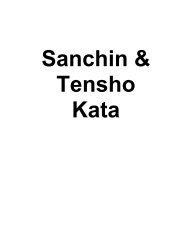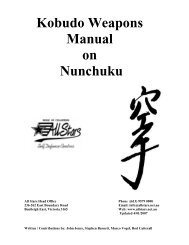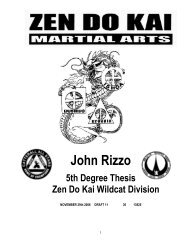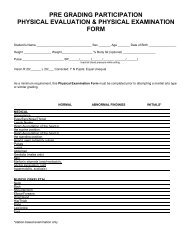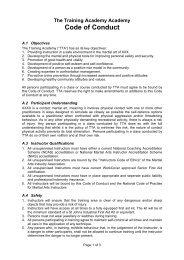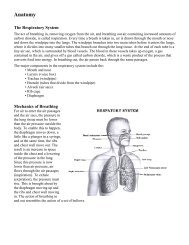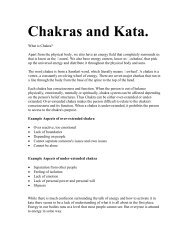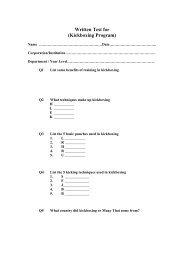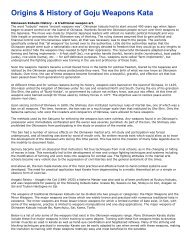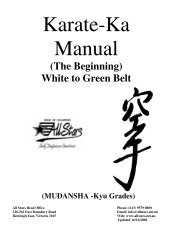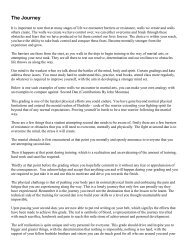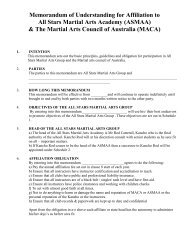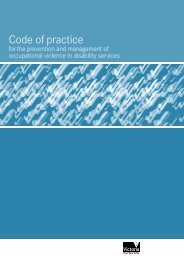Bo weapons_manual.pdf - All Stars Self Defence Centres
Bo weapons_manual.pdf - All Stars Self Defence Centres
Bo weapons_manual.pdf - All Stars Self Defence Centres
- No tags were found...
You also want an ePaper? Increase the reach of your titles
YUMPU automatically turns print PDFs into web optimized ePapers that Google loves.
Disclaimer/WaiverThe writer has no control over the use of these <strong>manual</strong>s byother persons, parties and institutions and will not acceptliability and denies any liability to any person, party orinstitution using, relying or in any manner what so everdealing with these <strong>manual</strong>s or any part there of.WARNING.These <strong>manual</strong>s cannot be used in the absence of direct face toface instruction with an experienced and qualified trainer.- Page 2 of 22 -
Origins of Martial Arts WeaponsOkinawan Kobu-do - A traditional weapon art.The word "kobudo" means "ancient <strong>weapons</strong> way". Okinawan kobudo had its start around 400 yearsago when Japan began to assert control over the Island of Okinawa. Warlords forced the Okinawanpeople to turn over their <strong>weapons</strong> to the Japanese. The move was made by Imperial Japanese leaderswith almost no realistic political foresight and very little insight or perception into the Okinawan wayof thinking. The ruling classes assumed that to gain political and financial control over this tenaciousisland race, all that was necessary was to disarm the people. The warlords specifically ordered that "all<strong>weapons</strong>" be turned over to the authorities. Little did the authorities realize that the Okinawan peoplewere such a nationalistic race and so strongly devoted to freedom that they would go to any lengths todeceive and/or hide the <strong>weapons</strong> they needed to fight their oppressors. The resourceful Okinawansadapted everyday farming and fishing implements -- 6-foot staff (bo), rice-grinder handle (tonfa),horse's bridle (nunchiyaku), boat paddle (ueku), rice sickle (kama), etc. -- for self-defensive purposes.Thus, <strong>weapons</strong> were called "farm implements", but underground the fighting population was trainingin the use and proficiency of these tools. Soon the <strong>weapons</strong> masters became a most feared force in thebattle for political freedom, feared by the Japanese and idolized by the Okinawan people whoseprotectorate they were. This was the birth of what we now know as Okinawan Kobudo. Over time, theuse of these <strong>weapons</strong> became formalized into a beautiful, graceful, and effective art that has beenpassed down from generation to generation.The <strong>weapons</strong> of traditional Okinawan Kobudo can be divided into two groups or categories: the MajorWeapons and the Minor Weapons. The major <strong>weapons</strong> are those which are widely known andpracticed with numerous traditional kata in existence. The minor <strong>weapons</strong> are those lesser-known<strong>weapons</strong> for which a limited number of kata exist. In fact, with some of the <strong>weapons</strong>, practice islimited to <strong>weapons</strong> manipulations and one-step applications. The major <strong>weapons</strong> of Okinawan Kobudoinclude: <strong>Bo</strong>, Nunchuku, Tonfa, Sai, Kama.At different times and for various reasons during its history, <strong>weapons</strong> were banned on the island ofOkinawa. In 1429, Sho Hassi united the kingdom of Okinawa under his rule and renamed North andSouth. During the era of his grandson Sho Shin, the policy of "Bunji-Kokka", or government byculture not military force, was put into effect. At this time all <strong>weapons</strong> were banned except for thoseused by military forces. The objective was to restore peace and to disarm rival clans.Upon seizing control of Okinawa, the Shimazu clan instituted numerous rules of martial law, one ofwhich was a ban on all <strong>weapons</strong>. This time, however, the ban was on a much larger scale than thatinstituted by Sho-Shin. Only the Satsuma samurai, who were the invaders and conquerors of Okinawa,were allowed to have <strong>weapons</strong>.- Page 5 of 22 -
The methods used by the Satsuma for enforcing the <strong>weapons</strong> ban were ruthless. Any <strong>weapons</strong> found inan Okinawan's possession were immediately confiscated and the owner was severely punished. As partof the ban, the Shimazu also prohibited the Okinawans from participating in the study or practice ofthe martial arts.This ban had a number of serious effects on the Okinawan martial arts. <strong>All</strong> study and participation wasforced underground, and all teaching was done by word of mouth only. No written records exist whichwould allow us to trace the development of the Okinawan arts during this time period. This has led tothe creation of many false legends due to the inability to document facts.Secrecy became such an obsession that instructors hid true techniques from rival schools, as in thechanging or hiding of moves in kata. This eventually led to the development of new and uniquefighting techniques and systems including the modification of farming and work tools into <strong>weapons</strong>for combat use. The fighting attitudes in the martial arts schools became very violent due to thesuppression of civil liberties and the general sentiment of the times.And above all, the ban made Karate one of the most practical and effective hand-to-hand combatsystems ever developed. The need for practical application kept Karate from degenerating to a mostlytheoretical art or a simple or obscure form of exercise.Stances in Kobu-doIn karate, stancing is designed to provide control of center line. In <strong>weapons</strong>, the concept stays thesame, but the execution changes depending upon the length of the weapon. If your underlyingmovement concept is based upon the use of natural, relaxed body positioning - then the stancing usedwith ones <strong>weapons</strong> will need to adjust depending upon the length (range) of the weapon being used.In practice short range <strong>weapons</strong> such as the tekkos or techu will employ stancing close to that used inones open hand movements. As the weapon range increases to the mid-range <strong>weapons</strong> (such as tunfa,sai, kama, nunchaku) and out to long-range <strong>weapons</strong> (bo, nunte bo, naganata) the width of the stancereduces in order to permit the natural position of the end of the weapon to be able to control thecenter line. In this manner one can learn to maximize their power of execution while minimizing theamount of power exerted to accomplish the movement. Also when playing with <strong>weapons</strong> theassociated concepts of minimizing ones target and being able to employ angular attacks, goes hand inhand with the use of relaxed natural movement in ones stancing and method of movement.As an interesting observation to having taught and observed numerous practitioners from variouskarate styles work kobudo over the years, I have found that the longer they are training (in a naturalrelaxed lineage focus), the more that they become similar in their movement - even though they mayhave started out from different karate movement perspectives.- Page 6 of 22 -
Masters of Kobu-doSources of information on kobo-do are scarce. Kobu-do dojo able to teach the original material is rare.This has forced much of todays teachers in creating kata and techniques because records of the art`sdevelopment are virtually non-existent. Having this lack of kobu-do material much of the art waspractised and developed in absolute secrecy, in the night time darkness of secret mountain retreats orsealed of in other similar places, safe from the intrusive eyes of any unwelcome people. To helpunderstand the lack of kobu-do information, the few masters of bo-jitsu (the art of using the bo ) are asfollows :Shinken TairaShinken Taira was born in 1890 (the 33 rd year of Meiji) in Kumijima City on the island of Okinawa.In 1923, he began studying karate under Master Gichin Funakoshi, founder of the art, and later,received intensive Okinawan kobu-do instruction from Master Mouden Yahishisa. After many years ofrigorous training, he earned his Master`s Degree and moved to Ikaho City in Gunma region, Japan.There he opened his first of many dojos and taught both karate and kobu-do. In 1940 (the 15 th year ofShowa), he returned to Okinawa and, in Naha, he established a dojo devoted purely to the art of kobudo.Although Master Taira passed away in 1970, the art lives on and flourishes through his students.One of them, Fumio Demura, has become over the years a leading exponent of kobu-do.SueyoshiWhile it is known that Master Sueyoshi was born sometime during the early 1900s, with oneexception no other details of his life have been recorded. This one exception is his kata for the bo,Sueyoshi-No KonToyama<strong>Bo</strong>rn in the early 1900s, Master Toyama founded the style of bo-jitsu called Toyama-Ryu-<strong>Bo</strong>-Jitsuand his kata, Toyama-No-Kon remains for modern students to practice.Chinen of Yamane-Ryu<strong>Bo</strong>rn in the early 1900s, Master Chinen`s extensive studies of bo-jitsu made him a specialist in theart. He developed many kata for the bo, among them Shuushi-No-Kon, Shirotaru-No-Kon (known inOkinawa as Ogusuku) and Yonegawa-No-Kon (Gyaku-<strong>Bo</strong>). Several of his students later becamefamous karateka renowned for their skill in kobu-do.Aragaki SeishoMaster Aaragaki, also born in the early 1900s, founded the Aragaki-Ryu style of kobu-do. Hisparticular specialties were bo-jitsu and sai-jitsu (the art of using the sai). Aragaki the Cat (1840-1920)a Nahe te Master was also said to of been proficient at Ryukyu Kobudo, and was responsible forpassing on the following Kobudo Kata: Urasoe <strong>Bo</strong>, Sesoko no Sai, Shokyu no Kon, Aragaki no Saiand Tsuken Hantagwa no Sai.TsukenMaster Tsuken, born in the late 1800s, formulated a kata called Tsuken-Hantagawa-No-Kon (alsoknown as Tsuken-bo) which was the culmination of all his kobu-do training. It was characterized by acertain twist known as gyaku-bo or reverse or left-handed bo.MiyazatoApart from dating his birth sometime during the late 1800s, the only records available on MasterMiyazato tell of his pilgrimage to China. There he studied not only “empty-handed” martial arts but- Page 7 of 22 -
the use of <strong>weapons</strong> as well. It is said Master Miyazato was invincible in the art of bo-jitsu. Themovements of his kata, Miyazato-bo, seem to reflect his strength and vigour.Sueishi<strong>Bo</strong>rn sometime during the mid-1800s, Master Sueishi belonged to a very prominent samurai familyliving in Shuri on the island of Okinawa. Although he received instruction in many different styles ofkobu-do, his specialty was bo-jitsu. He formulated two very precise and beautiful bo-jitsu kataknown as Sueishi-No-Kon and Shoun-No-Kon.Shitanaka Chinen<strong>Bo</strong>rn into a poor family of the late 1800s, Master Chinen originally came to Master Sueishi only toserve as his houseboy. Yet for many months, he would secretly watch his master`s martial arts classes,taking in as much of it as he could. Then, between chores, he would go off alone and practice differenttechniques. Eventually, Master Sueishi became aware of the boy`s interest. Watching the youthpractise and impressed with how passionate Chinen was for the martial arts, he granted the boypermission to attend formal lessons. Master Chinen studied both bo-jitsu and sai-jitsu and laterdeveloped Chinen-Shitanaka-No-Kon, a beautiful kata with very precise, sharp movements.SakugawaMaster Sakugawa was born during the mid-1800s in Suri on the island of Akata, Okinawa. As withMaster Miyazato, his thirst for more expertise in kobu-do led him to China. There he studied the use ofthe bo and other traditional Chinese <strong>weapons</strong>. On returning to Okinawa, he devised many dynamic,powerful kata, the most famous is Sakugawa-No-Kon.Donchi GinowanA foremost pupil of Master Sakugawa, Master Ginowan`s own skill in kobu-do was formidable and,after Master Sakugawa`s death, it is said his skill was unmatched. However, the dynamism and powerwhich marked his bo-jitsu style was so that it bordered on imitations of his late sensei`s methods.Tsuken KouruguwaVery little background information can be found on Master Kouruguwa apart from the fact that, as avery accomplished master of kobu-do, he developed the bo-jitsu kata Urazoe-No-<strong>Bo</strong>-Kon and theKouruguwa style of using the sai.Nakanhari No JiiMaster Nakanhari had a reputation as an extremely experienced kobu-do artist. No otherinformation on him exists. Even his particular style is unknown.MatsumuraAn expert in both karate and the use of <strong>weapons</strong>, Matsumura`s “empty-handed” training heavilyinfluenced his style of kobu-do which became known as Matsumura-Ryu.Akahachi Oyakei<strong>Bo</strong>rn in the-1700s on the island of Yaeyama, Okinawa, stories and legends indicate that MasterOyakei was the strongest, most accomplished bo-jitsu man of his time. His bo-jitsu legacy to modernstudents is a kata Akahachi-No-Gyakubo (reverse or left-handed bo).- Page 8 of 22 -
The Samurai MastersMost well known SamuraiMuromachi – Sengoku (1334 - 1573)• Tsukahara <strong>Bo</strong>kuden• Kamiizumi Nobutsuna• Marume Kurando• 1467 The Onin War happened and the Age of Civil Wars started.• 1573 Oda Nobunaga banished the general and the Muromachi government went to ruin.Azuchi Momoyama (1573 - 1603)• Ito Ittosai• Ono Tadaaki• Yagyu Munenori• Miyamoto Musashi• 1582 Oda Nobunaga was killed by Akechi Mitsuhide in Honno-ji temple.• 1590 Toyotomi Hideyoshi governed all the districtsEdo (1603 - 1867)• Yagyu Jyube• Kawakami Gensai• Okada Izo• Tanaka Shinbe• Nakamura Hanjiro• Saigo Takamori• 1603 Tokugawa Ieyasu became a generalissimo shogun.• 1702 The 47 Ronin incident happened and Kira Kozukenosuke was killed.• 1868 The Meiji Restoration happened and Tokugawa shogunate went to ruin.- Page 9 of 22 -
Origins of Martial Arts Weapons<strong>Bo</strong> JutsuAs with many <strong>weapons</strong> of ancient heritage, the exact origin of the bo, or kon or straight staff isobscure. Anthropologists know, however, that it was among the first tools used by early man to helphim survive. Initially, it took the form of a stick, a branch from a tree or a club and was used both todefend against attackers and to acquire food. Over the ages, the use of the bo or kon as a weapon hasbeen developed and refined. Still, because modern practitioners hesitate over the exact details of itsevolution, several theories on the history of the bo, as it is known today prevail. Whether factual ornot, one very popular theory exists: Around 517 A.D., the Zen Buddhist priest Daruma Daishi, theleader of the Shorin-ji Temple in China, brought into effect fluent use of the bo. During this period ofChinese history, government control was minimal and law and order belonged only to those capable ofsecuring it for themselves. For Daruma and his pupils, proficiency in the martial arts and the use of<strong>weapons</strong> like the spear, the sai and bo provided the only practicable means of defending their temple.The bo-jitsu techniques Daruma ordered his followers to master and perfect greatly influenced the laterdevelopment of Ryukyu Kobu-Do.Ryukyu Kobu-Do, the Okinawan art of using karate <strong>weapons</strong> such as the bo, the sai, the kama (sickle)and the nunchaku, first gained reputation around 1314 A.D. when the Japanese government passed twolaws that outraged the people of Okinawa. First, it barred all the population of the island from owningor possessing any sort of lethal weapon. Second, it forced on them a massive increase in taxes.Deprived of any conventional means of physical protest or retaliation, the people turned not only toempty-handed martial arts for protection, but to their farm implements as well, using them as <strong>weapons</strong>which eventually became the tonfa, nunchaku, kama, kai (boat oar) and the bo. The bo itself originatedwith the tenbin, a stick held across the shoulders, usually with buckets hanging from them at each end,that was used to transport food, water and other materials of importance. When the need arose, thetenbin, or the bo as it is known today, was manipulated to strike or block in techniques based on orvery similar to those used by Daruma and his disciples. The bo is either a five or six foot staff which isused in the Japanese art <strong>Bo</strong>jutsu. The best known staffs are the Japanese bo and jo. The bo staff ismade of hardwood would be made to a length of 6ft (although it is common these days to alter thelength to suit the user) and has a diameter of about 3.5 inches. The jo staff is more appropriately astick, because it is much shorter. Its art is called Jojutsu. Staffs are used to defend against swords andto thrust and to sweep.In it's original form and usage, the Okinawan <strong>Bo</strong> would have been similar to the Chinese equivelentand had an equal diameter throughout the length of it's shaft, but as time wore on and the <strong>Bo</strong> becamean effective weapon, a taper at each end developed which allows for a much more focused andeffective strike. Its ends are used to strike an opponent’s eyes, throat, and solar plexus of groin. It canalso be used to block an attack as well as to sweep the feet. The length of the <strong>Bo</strong> also makes it a goodweapon in defence against swords and to disarm an opponent while allowing the <strong>Bo</strong> wielder to remainat a safer distance.- Page 10 of 22 -
Chinese staffs can be used with some spear techniques. Staffs in Asia are known by the differentnames of barn, bong, forked staff, hanbo, lathi, naboot, rod, short staff, tabak, tambo, tanbo, tekken,three section staff and tienbong. The walking cane was often converted to use as a staff, especiallyamong monks who were otherwise unprotected. The barn is a Chinese long staff. It is very similar tothe long rod, but has a heavy metal fitting at one end, sometimes with serrated edges, as on a wolfteeth staff. The long rod is a Chinese weapon from five to eight feet long. It was made of hardwood,brass or iron. It was used as a defensive weapon against a sword or a knife. The techniques used werebrushing, sweeping and striking. The tapered rod is also a Chinese weapon. It could be used byfighters on horseback and it was also used to attack a horse`s legs. There are three lengths-(Long) 8feet or more, called shuo. (Medium) less than 8 feet long, called shi. (Short) about 4 feet long, calledgiau chiz.Although the actual size and dimension of a bo depend on the individual student`s needs, the standardbo or kon is straight, six-foot-long roku shaku-bo. Measuring about 31mm in diameter, it tapers out to19mm in diameter at each end. This tapered construction of the bo functions in several ways:1) It insures an even balance and guarantees that the bo`s fulcrum stays at its centre.2) It facilitates easy handling and effortless manoeuvring.3) It reduces rigidity and increases the bo`s tensile strength, thereby preventing breakage.4) These features give the bo a strong, powerful whipping action for striking and blocking.While most bo posses this tapered structure, they do vary in length and shape. Apart from the standardsix-foot measurement, bo range anywhere from four feet in length (yon-shaku-bo) to nine feet inlength (kyu-shaku-bo). They are usually round or circular at the centre and maintain this shape as theytaper out. Although modern students use the circular shaped bo almost entirely in their training, earlypractitioners of bo-jitsu often took square, hexagonal or octagonal shaped bo into combat because themultiple edges provided a more destructive effect.Modern bo-jitsu men use strong, hard wood, preferably red or white oak, in the construction of their<strong>weapons</strong>. In earlier days, however, strong bamboo was sometimes substituted for the wood, resultingin a surprisingly sturdy and effective bo.- Page 11 of 22 -
- Page 12 of 22 -
Throughout the world there are several methods of Okinawan kobudo being practiced. Amongst themost popular of these powerful & modern traditions are the Yabiku-Taira and Matayoshi methods.Given the name Yamaneryu by Chinen Masami (1898-1976,) the grandson of Chinen Sanda, the term isactually brings together three separate Chinese ideograms:1. "Yams," meaning "mountain;"2. "Ne," meaning "foundation or root;" and3. "Ryu," meaning, "stream." The term was simply intended to describe the locale in Shuri'sSamukawa village from whence Chinon's tradition came.It utilises natural mechanics and natural momentum developed through the movements.It may be apparent that there is a significant difference between modern kobudo and that of Oshiro-haYamaneryu. A simple explanation tells us that such differences came about largely due to kobudounfolding alongside modern karate. In the same way that old school Okinawan karate conformed to thepowerful forces of Japanese-ness, so too was modern kobudo similarly influenced. Introduced to themainland of pre-war Japan during an era of radical military escalation the original practice & purpose ofkarate & kobudo took on characteristics uniquely Japanese and have, for the most part, remained thatway (McCarthy)One method, however, untouched by this modern phenomenon was the tiny village-style of the Chinenclan. While the actual evolution of Yamaneryu bojutsu remains the subject of intense curiosity we doknow that the origins of this unique clan-style can be traced back through Chinen Pechin (c. 1846-1928)(McCarthy). At the centre of these principles, is the need to ensure that the hands are held close togetheras they grip the <strong>Bo</strong> during spins, swings and strikes. This aids in the utilisation of the body with themovements of the <strong>Bo</strong>. Such use of the body, close grip, full movement spinning, swinging and striking,provides power through each movement, as well as control.The exercises are an important aspect that must be practiced regularly and religiously, in order todevelop fluidity, control, balance, power and dexterity.Once the individual exercises have been practiced, it is imperative that the drills be practiced. There arenumerous that one could work on. The variety of drill should only be limited by your imagination andcreativity. The contents of this document in no way replace the necessity for actual instruction. Itmerely intended to provide some references and a starting point for students and instructors in thestudy and practice of <strong>Bo</strong>jutsu.- Page 13 of 22 -
Basic Exercises and DrillsWarm up exercise for the bo1. Wrist rolls.2. Vertical hand slide with bo on the ground.3. Vertical hand slide with bo off the ground.4. Horizontal hand slide (flip over)5. Horizontal hand slide (pull through)6. Standing spin7. Right side body turn and spin8. Left side body turn and spin9. Right side figure eights10. Left side figure eights11. Two handed figure eightsKamae stances and postures for the bo1 Step backleft foot into shiko dachi stance side on squatting stance2 Step up with left foot into half lunging stance lower parry down on 45 degrees to RHS3 Step forward left foot half lunging stance 45 degree upper parry to LHS4 Lung back R foot half lunging stance with bo in the Waki kami position behind in a lowerposture.5 Step back with left foot into crossed legged stance with bo in the Haso kami position Verticalinline with shoulders , turn upper body side on.6 Unwind body ending up in side on fighting kami similar to opening move but narrower7 Step left foot across to LHS half lunging stance vertical block to RHS8 Step up left foot to right foot bring bo down and over finish in start position.- Page 14 of 22 -
Kata<strong>Bo</strong> Weapons KataWhere:(RFF) - Right foot forward (Current movement)(RFB) - Right foot back (Current movement)(LFF) - Left foot forward (Current movement)(LFB) - Left foot back (Current movement)(LFL) - Left foot Left (Current movement)(BRS) - <strong>Bo</strong> right side (After movement)(BLS) - <strong>Bo</strong> left side (After movement)Offensive Side1. Step back kami, fighting stance (RFB) (BRS) Short pause.2. Step through overhead strike, deep stance (RFF) (BLS)3. Step back lower block, deep stance (RFB)4. Step through side strike, horse stance (RFF) (BLS) Short pause.5. Step through overhead strike, deep stance (LFF) (BRS)6. Step back lower block, deep stance (LFB)7. Step through side strike, horse stance (LFF) (BRS) Short pause.8. Step through over head strike (tension), bear stance (RFF) (BLS)9. Step through over head strike (tension), bear stance (LFF) (BRS)10. Pivot side block (BRS)11. Pivot back, overhead strike (BLS)12. Side strike (BRS)13. Step sideways deep stance (LFL), sweeping lower block (BLS)14. Return to shoulder width stance.- Page 15 of 22 -
Where:(RFF) - Right foot forward (Current movement)(RFB) - Right foot back (Current movement)(LFF) - Left foot forward (Current movement)(LFB) - Left foot back (Current movement)(LFL) - Left foot Left (Current movement)(BRS) - <strong>Bo</strong> right side (After movement)(BLS) - <strong>Bo</strong> left side (After movement)Defensive Side1. Shoulder width stance Short pause.2. Step back overhead block, deep stance (LFB)3. Step through groin strike, deep stance (LFF) (BRS)4. Step back side block, horse stance (LFB) (BLS) Short pause.5. Step back overhead block, deep stance (RFB)6. Step through groin strike, deep stance (RFF) (BLS)7. Step back side block, horse stance (RFB) (BRS) Short pause.8. Step back block across (with tension), bear stance (LFB) (BLS)9. Step back block across (with tension), bear stance (RFB) (BRS)10. Step around with RF, centre jab (BRS)11. Return to bear stance, overhead block12. Side block (BRS)13. Step sideways deep stance (LFL), sweeping lower block (BLS) Short pause.14. Finish routine- Page 16 of 22 -
Personal KataPersonal kata. This is your personal statement on both style and personal standards.Kata must have a name (English & Japanese) theme, start & finish on the same spot and gono less than and no longer than 60 seconds.(Main points only)Centre runs- a three times repeated sequence advancing forward.(Main features:stability, focus, power, and precise technique)Complex-(Main features:complex angles, footwork, advanced kickcombinations, balance, multi directional attack/defence, speedand dexterity)Visual finish-(Main features:flexibility, balance, gymnastics, acrobatics skillsand aerial work)- Page 17 of 22 -
Weapons Nominated <strong>Self</strong> <strong>Defence</strong> Responces<strong>Bo</strong>jutsu <strong>Self</strong> <strong>Defence</strong>Where:(RFF) - Right foot forward (Current movement)(RFB) - Right foot back (Current movement)(LFF) - Left foot forward (Current movement)(LFB) - Left foot back (Current movement)(LFL) - Left foot Left (Current movement)(BRS) - <strong>Bo</strong> right side (After movement)(BLS) - <strong>Bo</strong> left side (After movement)First Attack1. Step back kami, fighting stance (RFB) (BRS)2. Step through overhead strike, deep stance (RFF) (BLS)First Defensive1. Shoulder width stance2. Parry (block) to left, half stance (LFB)3. Double scrape4. JabSecond Attack1. Step back kami, fighting stance (RFB) (BRS)2. Lunge forward jab to mid section, deep stanceSecond Defensive1. Shoulder width stance2. Block across, half stance (RFB)3. Head strike (LFF)4. Step in groin strikeThird Attack1. Step back kami, fighting stance (RFB) (BRS)2. Step through groin strike, deep stance (RFF) (BLS)Third Defensive1. Shoulder width stance2. Step back downward block, deep stance (RFB)3. Sweeping block to right4. Step up to half stance (RFB)5. Step back cat stance, DOH strike (LFB)- Page 18 of 22 -
Hakama Ceremony1.The lai-do-gi consists of two pieces: the top jacket and the Hakama. The jacket is normally white(with black stitching) or dark blue and the Hakama normally dark blue or black.Beginners usually wear the white and black stitched top. The Hakama most commonly worn inpractice is dark blue or black. Tops and bottoms should never be mixed, eg. White top with blackbottom or black top with a white bottom. Of course, if you are a beginner, then the white top with theblack stitching and the dark Hakama is quite acceptable.The Hakama allows complete movement andits bell bottoms permit good air circulation when you are practicing lai - do.Kendo has profound precepts, many of which reflect the virtuous culture from which it comes. Forexample, there is a fascinating correspondence between the design of the Hakama and the constructionof the shinai. The Hakama has five seperate folds in the front but only one in the back, compared to thefive segments of bamboo of which a shinai is comprised. Each has a specific meaning relating to anattitude, which is fostered in the art of kendo. (As karatedo is also an equal part of this larger whole,budo, the same can apply to it too.)1. Jin: Perfect virtue, humanity and benevolence. Caring for others, giving without expectingany thing in return. Sympathy and thoughtfulness.2. Gi: Justice, morality and loyality. Living the correct way. An obligation to do right with astrong sense of duty. Being trusted by others.3. Rei: The act of humilty, courtesy and gratitude. Proper manners as a way of life. Respect andappreciation.4. Chi: Wisdom, intelligence and rational thinking.5. Shin: Sincerity, faith and genuine trust.6. Sei: Sincerity, truth and faitfulness.- Page 19 of 22 -
PUTTING ON THE HAKAMA. AS YOU STEP INTO THE HAKAMA, PUT THEKOSHI-ITA OR STIFFENER TO THE BACK.NOW, CROSSING THE CORDS IN FRONT ABOUT THREE INCHES DOWN FROM THE TOPIS PULLED DOWN TIGHT SO THAT THERE IS NOT A BULGE IN THE BACK.NOW PICK UP THE BACK OF THE HAKAMA WITH BOTH HANDS. PLACE THE KOSHI-ITAOVER THE BOW AND BRING THE CORDS TO THE FRONT.- Page 20 of 22 -
ABOVE SHOWS THAT ALL CORDS, FRONT AND BACK, ARE IN LINE CROSSING TO THEFRONT. TIE A SMALL KNOT IN THE CENTRE WHERE THE CORDS CROSS.AFTER THIS TAKE ONE END AND FOLD IT BACK AND FORTH ACROSS THE KNOTMAKING ALL ENDS EVEN.WHEN THIS IS FINISHED, TAKE THE OTHER END AND CIRCLE AROUND THE BOWUNTIL THERE IS NOTHING LEFT,- Page 21 of 22 -
WHEN YOU FINISH, IT SHOULD LOOK LIKE THE ABOVE DIAGRAM, WITH NO ENDSSHOWING.FOLDING YOUR TOP AFTER PRACTICE.- Page 22 of 22 -



